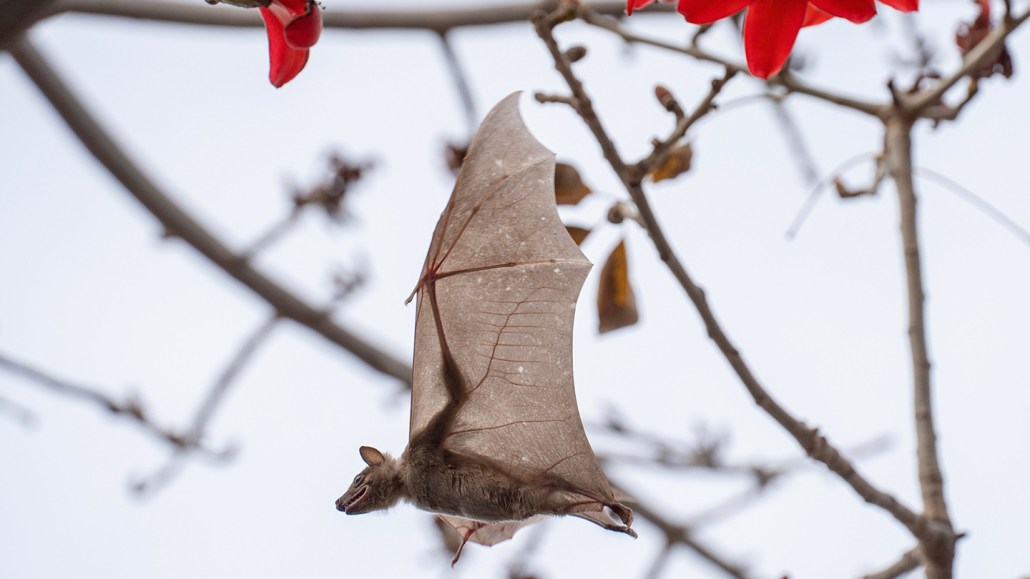
This Egyptian fruit bat, from a colony in central Tel Aviv, seems to be smiling, but it’s not an expression of joy. Rather, it is holding open its mouth so it can echolocate by projecting sound from its clicking tongue.
Yuval Barkai
- More than 2 years ago
Despite their excellent vision, one city-dwelling colony of fruit bats echolocates during broad daylight — completely contrary to what experts expected.
A group of Egyptian fruit bats (Rousettus aegyptiacus) in downtown Tel Aviv uses sound to navigate in the middle of the day, researchers report in the April 11 Current Biology. The finding greatly extends the hours during which bats from this colony echolocate. A few years ago, some team members had noticed bats clicking while they flew under low-light conditions. The midday sound-off seems to help the bats forage and navigate, even though they can see just fine.
Bats that are active during the day are unusual. Out of the more than 1,400 species, roughly 10 are diurnal. What’s more, most diurnal bats don’t use echolocation during the day, relying instead on their vision to forage and avoid obstacles. They save echolocation for dim light or dark conditions.
So that’s why, two years ago, a group of Tel Aviv researchers were surprised when they noticed a bat smiling during the day. They were looking over photos from their latest study of Egyptian fruit bats when they noticed one with its mouth slightly parted and upturned.
“When an Egyptian fruit bat is smiling, he’s echolocating — he’s producing clicks with his tongue and his mouth is open,” says Ofri Eitan, a bat researcher at Tel Aviv University. “But this was during the day, and these bats see really well.”
When Eitan and his colleagues looked through other photos — thousands of them — many showed smiling bats in broad daylight. The team showed in 2015 that the diurnal Egyptian fruit bats do use echolocation outdoors under various low light conditions, at least occasionally. But the researchers hadn’t looked at whether the bats were echolocating during midday hours when light levels are highest.
The scientists began to wonder just how rare this behavior was. “We hypothesized that fruit bats would rarely use echolocation in broad daylight,” the team writes.
So, the researchers trained their video and acoustic recording equipment on their study colony, which roosts on the ceiling of a mall’s underground parking lot in central Tel Aviv. After recording roughly 500 flying bats, the researchers had to admit they were wrong. Just over 70 percent of the bats regularly used echolocation as they emerged from their colony.
“We were surprised to see that,” Eitan says. “OK, so the bats are echolocating. But is it functional?”
Next, the team looked at whether the bats used echolocation while foraging, flying near and landing on fruit trees, and approaching an artificial pool to drink. The researchers discovered all the bats echolocated — some even while they had large pieces of fruit in their mouths.
The bats also significantly increased their click rates before landing on a branch or approaching the pool. In other words, the bats were stepping up their game as they got closer to scary obstacles to avoid crashing into them or landing badly.
“We suggest that echolocation provides better distance estimation accuracy than vision and is thus advantageous when flying near obstacles such as trees or when descending to drink,” the researchers write.
The team’s previous research also shows that when the bats fly high above the ground where there are no obstacles, they hardly smile and click, suggesting that they can stop using their echolocation when it’s not useful.
Most bat experts believe these mammals became largely nocturnal to avoid visual predators such as birds of prey. But “observations such as this one tell us that echolocation must be so hard-wired in bats that it keeps being used even when their sensitive eyes would suffice,” says Danilo Russo, a bat researcher at the University of Naples Federico II in Italy who was not involved in the study. “This is especially interesting in the species covered in the study, which still largely relies on vision besides using echolocation.”





